BN710712: Chronic Conditions and Person-Centred Care Report
VerifiedAdded on 2022/09/06
|17
|5350
|13
Report
AI Summary
This report presents a case study of a 65-year-old Bhutanese male with type 2 diabetes (T2DM), exploring the impact of the condition on his life and family. The report analyzes the patient's experience, including his physical and psychological challenges, and the influence of his cultural background. It discusses the typical onset, pathophysiology, potential complications, and lifespan considerations of T2DM. Furthermore, it examines the social constructions of the illness and their impact on the patient's management of the disease. The report concludes by outlining the appropriate nursing care needs for the client, considering his current health status and aiming for improved health outcomes. The report also addresses the patient's psychosocial stage, family dynamics, and the stigma associated with diabetes. The report is designed to provide a comprehensive understanding of the patient's situation and the complexities of chronic illness management.
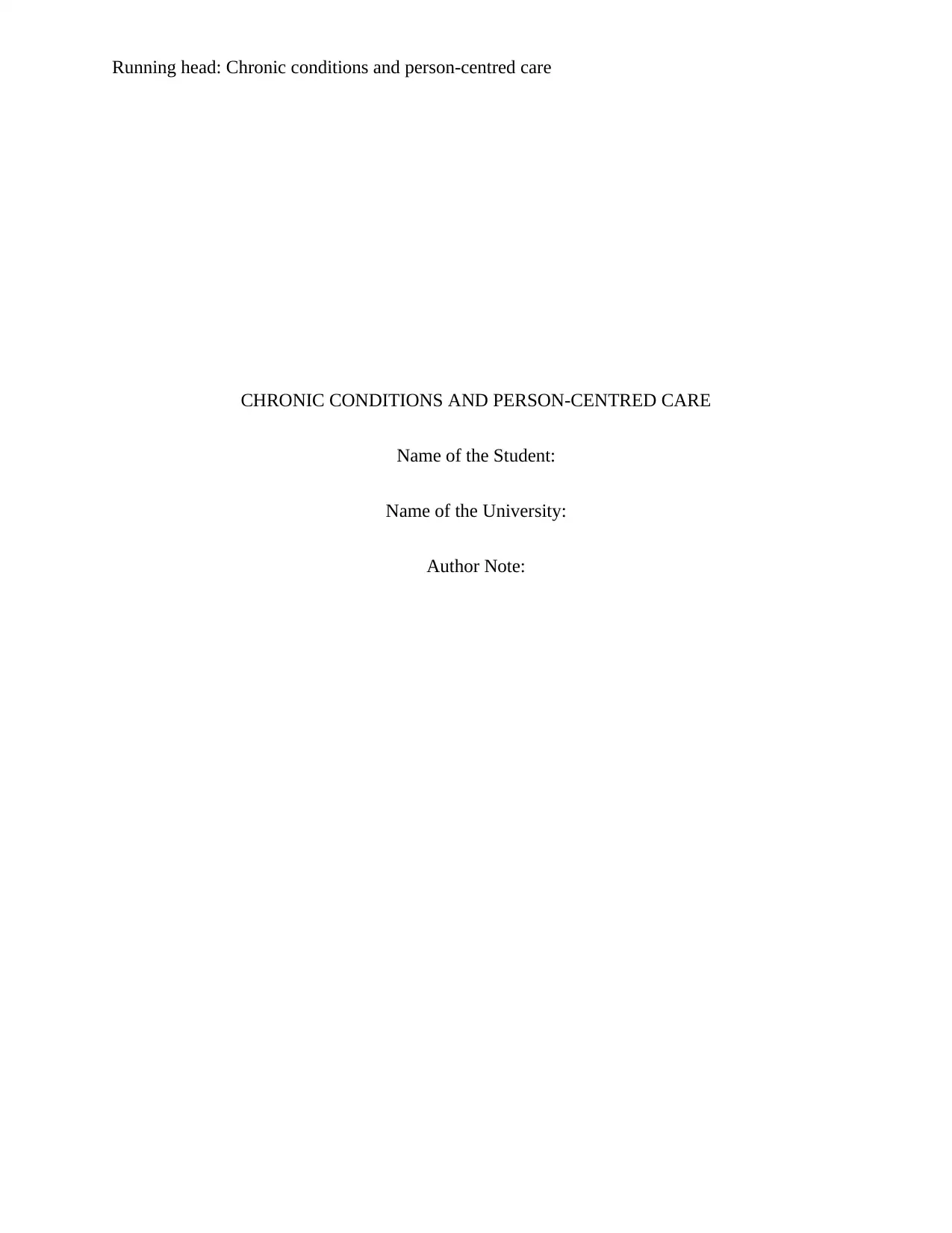
Running head: Chronic conditions and person-centred care
CHRONIC CONDITIONS AND PERSON-CENTRED CARE
Name of the Student:
Name of the University:
Author Note:
CHRONIC CONDITIONS AND PERSON-CENTRED CARE
Name of the Student:
Name of the University:
Author Note:
Paraphrase This Document
Need a fresh take? Get an instant paraphrase of this document with our AI Paraphraser
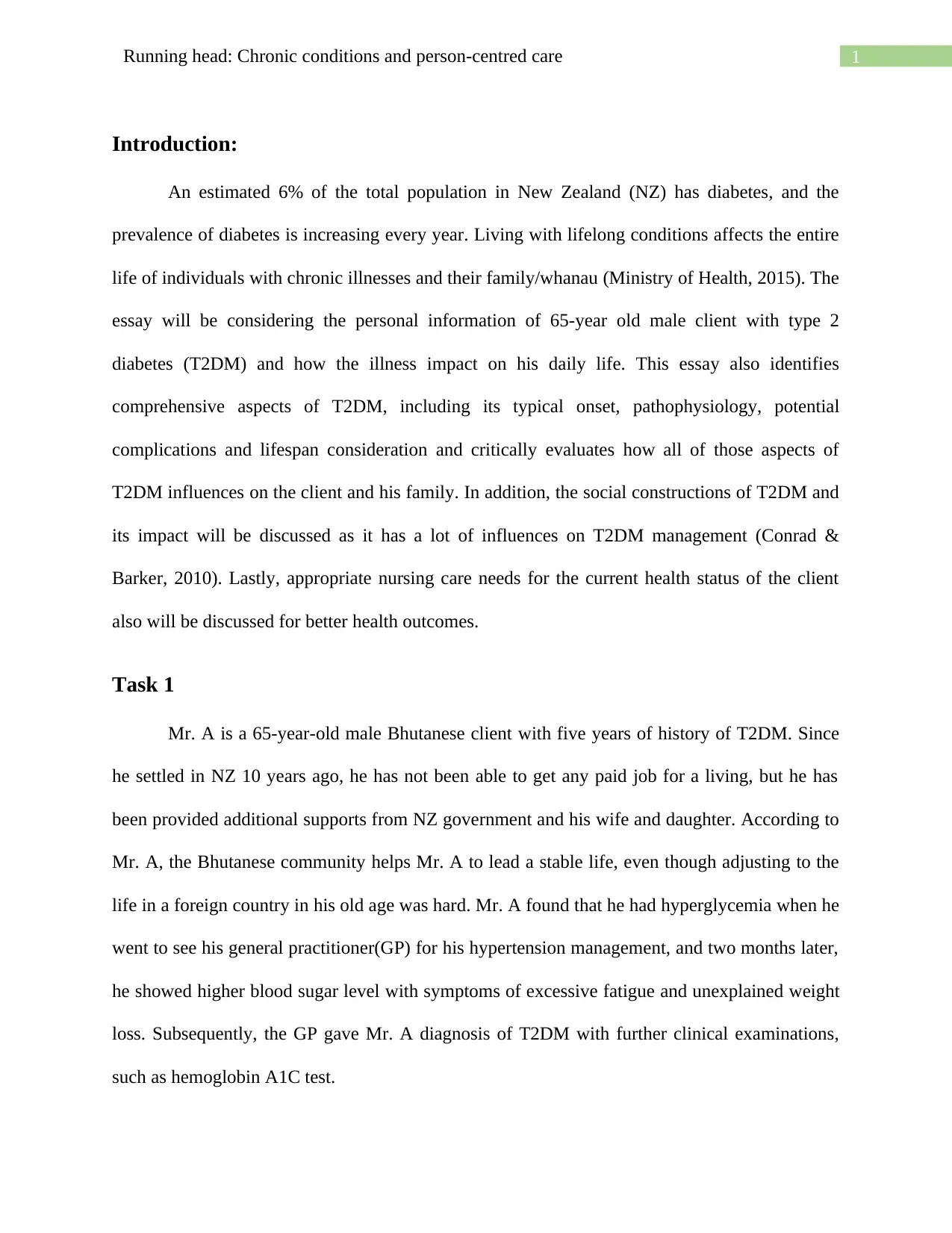
1Running head: Chronic conditions and person-centred care
Introduction:
An estimated 6% of the total population in New Zealand (NZ) has diabetes, and the
prevalence of diabetes is increasing every year. Living with lifelong conditions affects the entire
life of individuals with chronic illnesses and their family/whanau (Ministry of Health, 2015). The
essay will be considering the personal information of 65-year old male client with type 2
diabetes (T2DM) and how the illness impact on his daily life. This essay also identifies
comprehensive aspects of T2DM, including its typical onset, pathophysiology, potential
complications and lifespan consideration and critically evaluates how all of those aspects of
T2DM influences on the client and his family. In addition, the social constructions of T2DM and
its impact will be discussed as it has a lot of influences on T2DM management (Conrad &
Barker, 2010). Lastly, appropriate nursing care needs for the current health status of the client
also will be discussed for better health outcomes.
Task 1
Mr. A is a 65-year-old male Bhutanese client with five years of history of T2DM. Since
he settled in NZ 10 years ago, he has not been able to get any paid job for a living, but he has
been provided additional supports from NZ government and his wife and daughter. According to
Mr. A, the Bhutanese community helps Mr. A to lead a stable life, even though adjusting to the
life in a foreign country in his old age was hard. Mr. A found that he had hyperglycemia when he
went to see his general practitioner(GP) for his hypertension management, and two months later,
he showed higher blood sugar level with symptoms of excessive fatigue and unexplained weight
loss. Subsequently, the GP gave Mr. A diagnosis of T2DM with further clinical examinations,
such as hemoglobin A1C test.
Introduction:
An estimated 6% of the total population in New Zealand (NZ) has diabetes, and the
prevalence of diabetes is increasing every year. Living with lifelong conditions affects the entire
life of individuals with chronic illnesses and their family/whanau (Ministry of Health, 2015). The
essay will be considering the personal information of 65-year old male client with type 2
diabetes (T2DM) and how the illness impact on his daily life. This essay also identifies
comprehensive aspects of T2DM, including its typical onset, pathophysiology, potential
complications and lifespan consideration and critically evaluates how all of those aspects of
T2DM influences on the client and his family. In addition, the social constructions of T2DM and
its impact will be discussed as it has a lot of influences on T2DM management (Conrad &
Barker, 2010). Lastly, appropriate nursing care needs for the current health status of the client
also will be discussed for better health outcomes.
Task 1
Mr. A is a 65-year-old male Bhutanese client with five years of history of T2DM. Since
he settled in NZ 10 years ago, he has not been able to get any paid job for a living, but he has
been provided additional supports from NZ government and his wife and daughter. According to
Mr. A, the Bhutanese community helps Mr. A to lead a stable life, even though adjusting to the
life in a foreign country in his old age was hard. Mr. A found that he had hyperglycemia when he
went to see his general practitioner(GP) for his hypertension management, and two months later,
he showed higher blood sugar level with symptoms of excessive fatigue and unexplained weight
loss. Subsequently, the GP gave Mr. A diagnosis of T2DM with further clinical examinations,
such as hemoglobin A1C test.
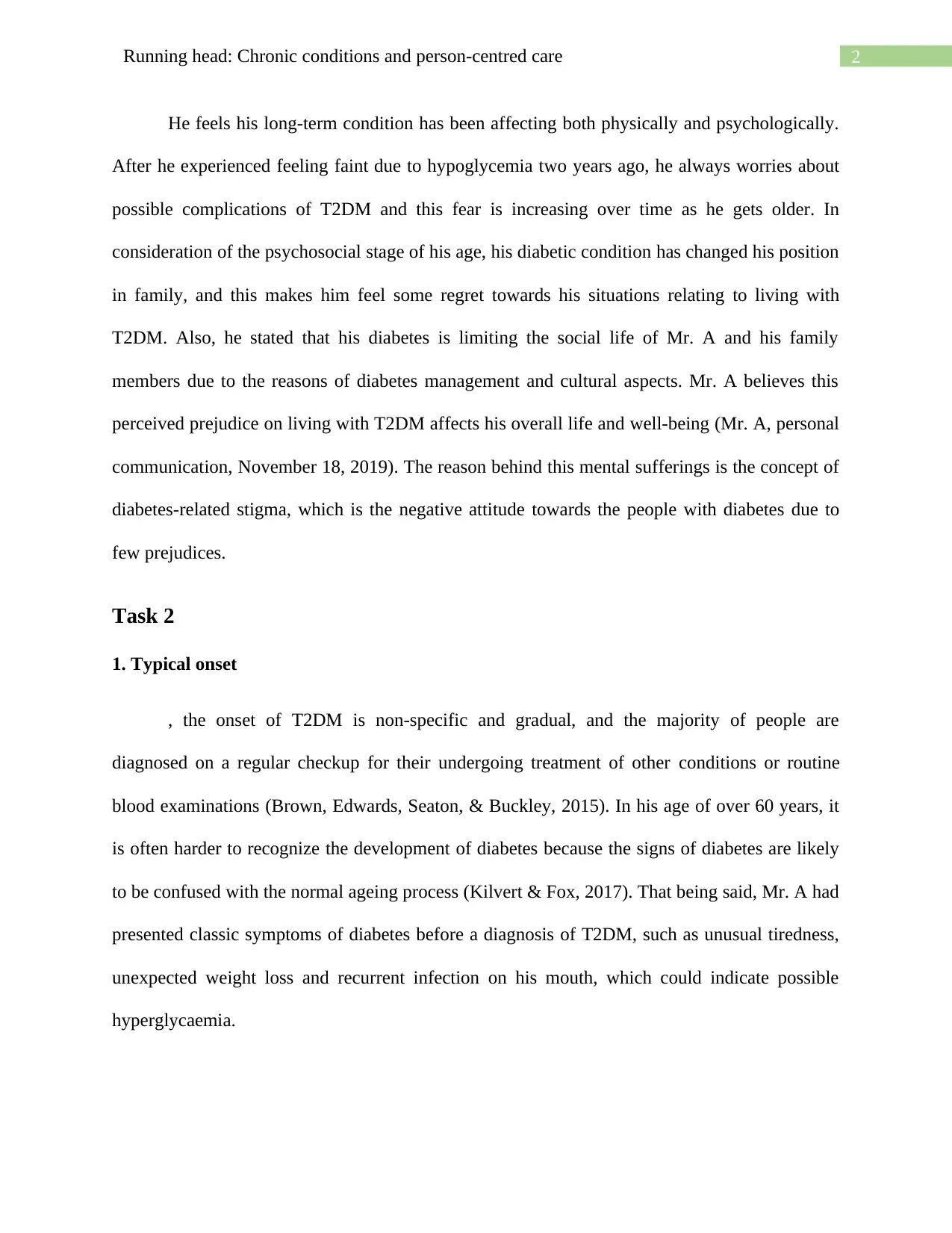
2Running head: Chronic conditions and person-centred care
He feels his long-term condition has been affecting both physically and psychologically.
After he experienced feeling faint due to hypoglycemia two years ago, he always worries about
possible complications of T2DM and this fear is increasing over time as he gets older. In
consideration of the psychosocial stage of his age, his diabetic condition has changed his position
in family, and this makes him feel some regret towards his situations relating to living with
T2DM. Also, he stated that his diabetes is limiting the social life of Mr. A and his family
members due to the reasons of diabetes management and cultural aspects. Mr. A believes this
perceived prejudice on living with T2DM affects his overall life and well-being (Mr. A, personal
communication, November 18, 2019). The reason behind this mental sufferings is the concept of
diabetes-related stigma, which is the negative attitude towards the people with diabetes due to
few prejudices.
Task 2
1. Typical onset
, the onset of T2DM is non-specific and gradual, and the majority of people are
diagnosed on a regular checkup for their undergoing treatment of other conditions or routine
blood examinations (Brown, Edwards, Seaton, & Buckley, 2015). In his age of over 60 years, it
is often harder to recognize the development of diabetes because the signs of diabetes are likely
to be confused with the normal ageing process (Kilvert & Fox, 2017). That being said, Mr. A had
presented classic symptoms of diabetes before a diagnosis of T2DM, such as unusual tiredness,
unexpected weight loss and recurrent infection on his mouth, which could indicate possible
hyperglycaemia.
He feels his long-term condition has been affecting both physically and psychologically.
After he experienced feeling faint due to hypoglycemia two years ago, he always worries about
possible complications of T2DM and this fear is increasing over time as he gets older. In
consideration of the psychosocial stage of his age, his diabetic condition has changed his position
in family, and this makes him feel some regret towards his situations relating to living with
T2DM. Also, he stated that his diabetes is limiting the social life of Mr. A and his family
members due to the reasons of diabetes management and cultural aspects. Mr. A believes this
perceived prejudice on living with T2DM affects his overall life and well-being (Mr. A, personal
communication, November 18, 2019). The reason behind this mental sufferings is the concept of
diabetes-related stigma, which is the negative attitude towards the people with diabetes due to
few prejudices.
Task 2
1. Typical onset
, the onset of T2DM is non-specific and gradual, and the majority of people are
diagnosed on a regular checkup for their undergoing treatment of other conditions or routine
blood examinations (Brown, Edwards, Seaton, & Buckley, 2015). In his age of over 60 years, it
is often harder to recognize the development of diabetes because the signs of diabetes are likely
to be confused with the normal ageing process (Kilvert & Fox, 2017). That being said, Mr. A had
presented classic symptoms of diabetes before a diagnosis of T2DM, such as unusual tiredness,
unexpected weight loss and recurrent infection on his mouth, which could indicate possible
hyperglycaemia.
⊘ This is a preview!⊘
Do you want full access?
Subscribe today to unlock all pages.

Trusted by 1+ million students worldwide

3Running head: Chronic conditions and person-centred care
Since Mr. A had diagnosed hypertension two years before his symptoms of diabetes
presented, his high blood pressure might be associated with the initial stage of the eruption of
diabetes. According to a study, although people with early stage of T2DM are not aware of
typical changes caused by diabetes, some damages on the heart and vascular systems may be
already occurring (Brown, Edwards, Seaton, & Buckley, 2015; de Boer et al., 2017). This is
because poor management of blood sugar decreases functions of heart and blood vessels
significantly by damaging blood vessel walls and thus increasing arterial stiffness (Ma et al.,
2014). Finally, he found that he had a higher level of fasting blood glucose on a regular checkup,
which is one of the most typical indicators of T2DM. As we can see from the case of Mr. A, an
asymptomatic period may be prolonged before noticeable signs associated with T2DM occurs,
and thus careful screening of diabetes-related symptoms is required for early identification
(Sinclair, Dunning, & Rodriguez-Mañas, 2015).
The incidence of T2DM is mainly caused by either insufficient insulin production or
insulin resistance of body cells (Brown, Edwards, Seaton, & Buckley, 2015). Also, a myriad of
risk factors triggers the development of T2DM, including sociocultural status, diet and lifestyle
(Kautzky-Willer, Harreiter, & Pacini, 2016). Importantly, Mr. A’s experience of resettling in
another country could contribute to developing T2DM because immigrants are more likely to be
exposed to different health risks, affecting dietary habit, physical activities and stress level,
which can increase the risk of T2DM (Berkowitz et al., 2016; Tenkorang, 2017). Mr. A also
experienced a rapid shift from traditional Bhutanese low-fat and balanced diet towards a diet that
is higher sugar and salt and meat-based food. Such a nutritional change might have compromised
metabolic functions and therefore contributed to increased development of T2DM (Wangdi &
Jamtsho, 2018).
Since Mr. A had diagnosed hypertension two years before his symptoms of diabetes
presented, his high blood pressure might be associated with the initial stage of the eruption of
diabetes. According to a study, although people with early stage of T2DM are not aware of
typical changes caused by diabetes, some damages on the heart and vascular systems may be
already occurring (Brown, Edwards, Seaton, & Buckley, 2015; de Boer et al., 2017). This is
because poor management of blood sugar decreases functions of heart and blood vessels
significantly by damaging blood vessel walls and thus increasing arterial stiffness (Ma et al.,
2014). Finally, he found that he had a higher level of fasting blood glucose on a regular checkup,
which is one of the most typical indicators of T2DM. As we can see from the case of Mr. A, an
asymptomatic period may be prolonged before noticeable signs associated with T2DM occurs,
and thus careful screening of diabetes-related symptoms is required for early identification
(Sinclair, Dunning, & Rodriguez-Mañas, 2015).
The incidence of T2DM is mainly caused by either insufficient insulin production or
insulin resistance of body cells (Brown, Edwards, Seaton, & Buckley, 2015). Also, a myriad of
risk factors triggers the development of T2DM, including sociocultural status, diet and lifestyle
(Kautzky-Willer, Harreiter, & Pacini, 2016). Importantly, Mr. A’s experience of resettling in
another country could contribute to developing T2DM because immigrants are more likely to be
exposed to different health risks, affecting dietary habit, physical activities and stress level,
which can increase the risk of T2DM (Berkowitz et al., 2016; Tenkorang, 2017). Mr. A also
experienced a rapid shift from traditional Bhutanese low-fat and balanced diet towards a diet that
is higher sugar and salt and meat-based food. Such a nutritional change might have compromised
metabolic functions and therefore contributed to increased development of T2DM (Wangdi &
Jamtsho, 2018).
Paraphrase This Document
Need a fresh take? Get an instant paraphrase of this document with our AI Paraphraser
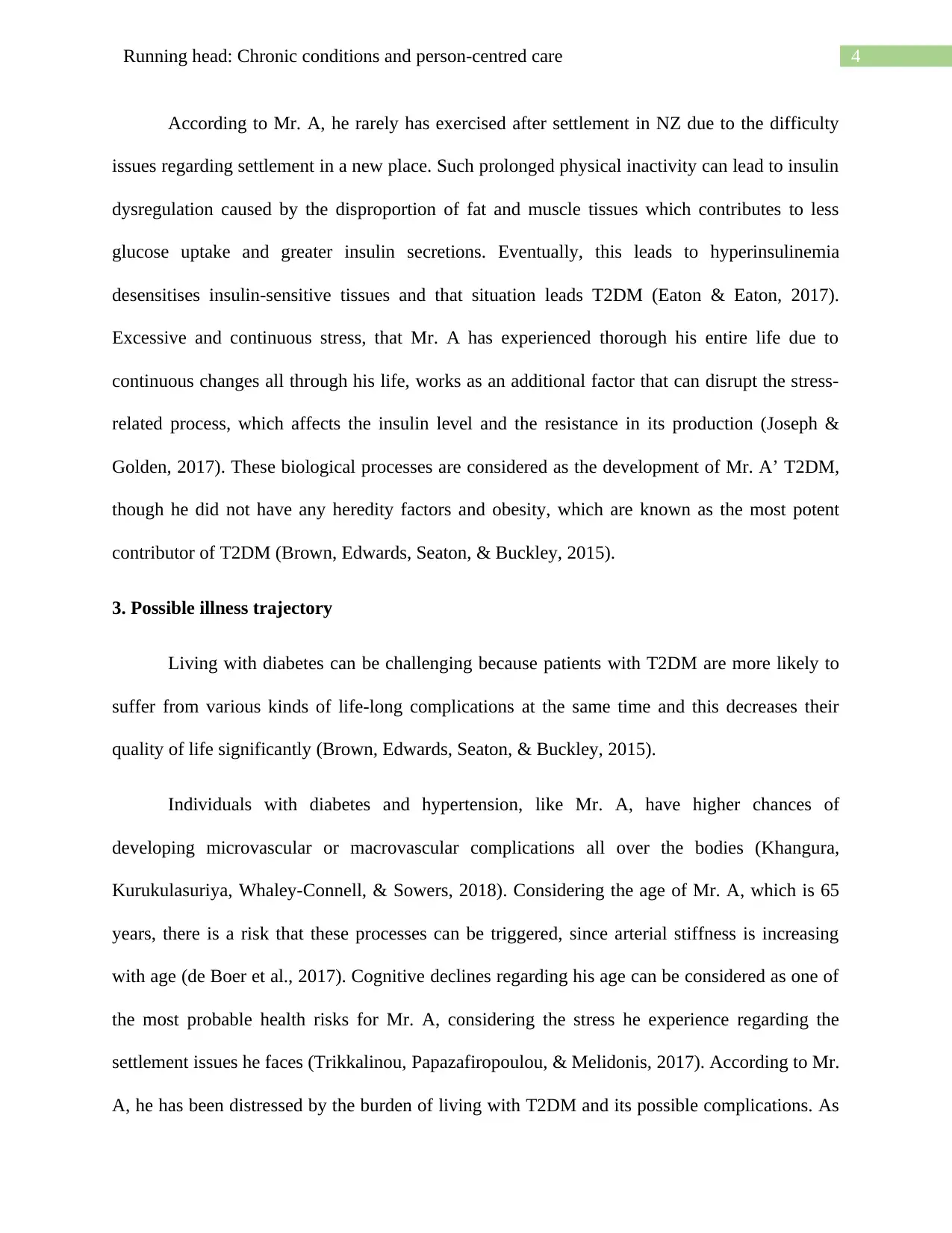
4Running head: Chronic conditions and person-centred care
According to Mr. A, he rarely has exercised after settlement in NZ due to the difficulty
issues regarding settlement in a new place. Such prolonged physical inactivity can lead to insulin
dysregulation caused by the disproportion of fat and muscle tissues which contributes to less
glucose uptake and greater insulin secretions. Eventually, this leads to hyperinsulinemia
desensitises insulin-sensitive tissues and that situation leads T2DM (Eaton & Eaton, 2017).
Excessive and continuous stress, that Mr. A has experienced thorough his entire life due to
continuous changes all through his life, works as an additional factor that can disrupt the stress-
related process, which affects the insulin level and the resistance in its production (Joseph &
Golden, 2017). These biological processes are considered as the development of Mr. A’ T2DM,
though he did not have any heredity factors and obesity, which are known as the most potent
contributor of T2DM (Brown, Edwards, Seaton, & Buckley, 2015).
3. Possible illness trajectory
Living with diabetes can be challenging because patients with T2DM are more likely to
suffer from various kinds of life-long complications at the same time and this decreases their
quality of life significantly (Brown, Edwards, Seaton, & Buckley, 2015).
Individuals with diabetes and hypertension, like Mr. A, have higher chances of
developing microvascular or macrovascular complications all over the bodies (Khangura,
Kurukulasuriya, Whaley-Connell, & Sowers, 2018). Considering the age of Mr. A, which is 65
years, there is a risk that these processes can be triggered, since arterial stiffness is increasing
with age (de Boer et al., 2017). Cognitive declines regarding his age can be considered as one of
the most probable health risks for Mr. A, considering the stress he experience regarding the
settlement issues he faces (Trikkalinou, Papazafiropoulou, & Melidonis, 2017). According to Mr.
A, he has been distressed by the burden of living with T2DM and its possible complications. As
According to Mr. A, he rarely has exercised after settlement in NZ due to the difficulty
issues regarding settlement in a new place. Such prolonged physical inactivity can lead to insulin
dysregulation caused by the disproportion of fat and muscle tissues which contributes to less
glucose uptake and greater insulin secretions. Eventually, this leads to hyperinsulinemia
desensitises insulin-sensitive tissues and that situation leads T2DM (Eaton & Eaton, 2017).
Excessive and continuous stress, that Mr. A has experienced thorough his entire life due to
continuous changes all through his life, works as an additional factor that can disrupt the stress-
related process, which affects the insulin level and the resistance in its production (Joseph &
Golden, 2017). These biological processes are considered as the development of Mr. A’ T2DM,
though he did not have any heredity factors and obesity, which are known as the most potent
contributor of T2DM (Brown, Edwards, Seaton, & Buckley, 2015).
3. Possible illness trajectory
Living with diabetes can be challenging because patients with T2DM are more likely to
suffer from various kinds of life-long complications at the same time and this decreases their
quality of life significantly (Brown, Edwards, Seaton, & Buckley, 2015).
Individuals with diabetes and hypertension, like Mr. A, have higher chances of
developing microvascular or macrovascular complications all over the bodies (Khangura,
Kurukulasuriya, Whaley-Connell, & Sowers, 2018). Considering the age of Mr. A, which is 65
years, there is a risk that these processes can be triggered, since arterial stiffness is increasing
with age (de Boer et al., 2017). Cognitive declines regarding his age can be considered as one of
the most probable health risks for Mr. A, considering the stress he experience regarding the
settlement issues he faces (Trikkalinou, Papazafiropoulou, & Melidonis, 2017). According to Mr.
A, he has been distressed by the burden of living with T2DM and its possible complications. As
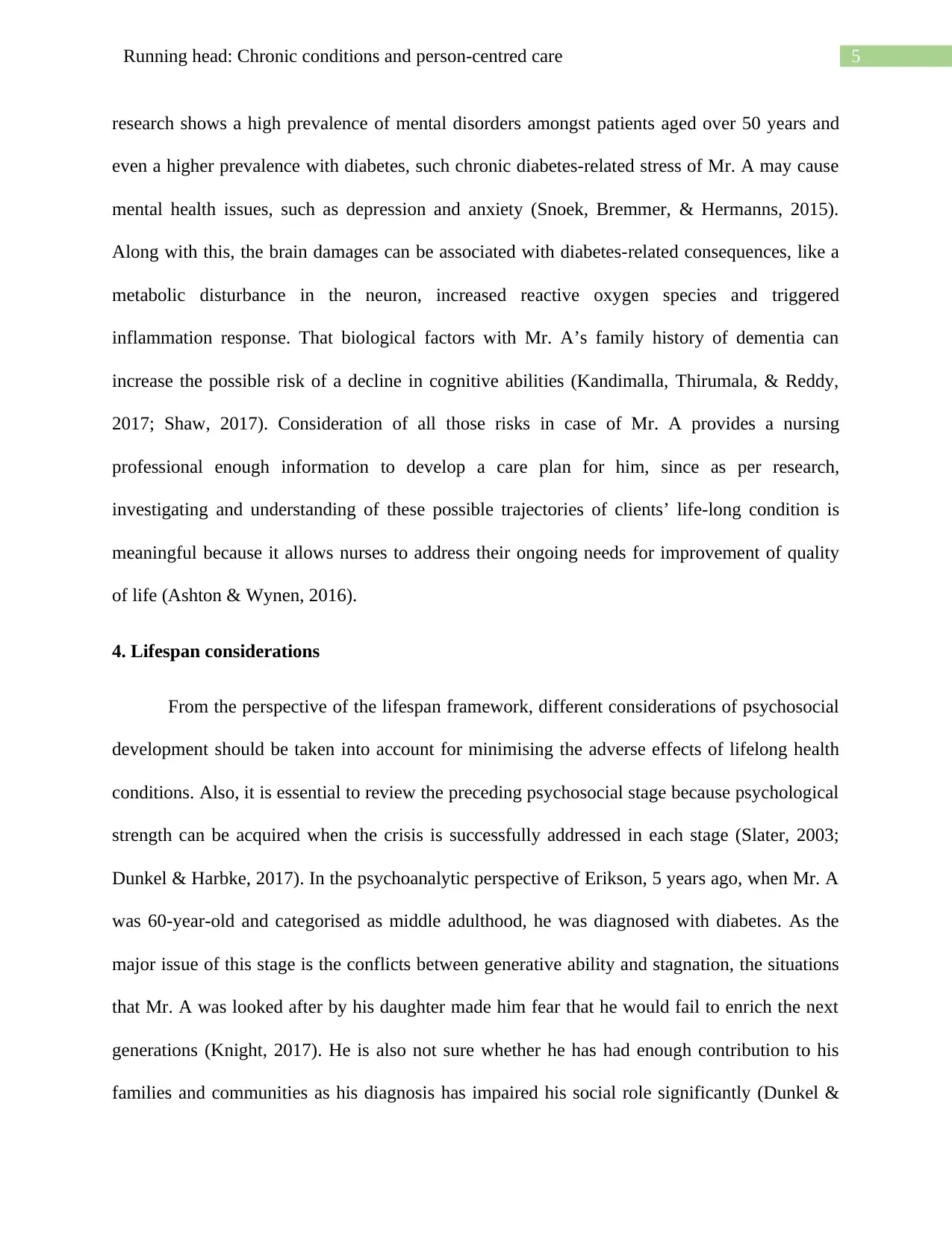
5Running head: Chronic conditions and person-centred care
research shows a high prevalence of mental disorders amongst patients aged over 50 years and
even a higher prevalence with diabetes, such chronic diabetes-related stress of Mr. A may cause
mental health issues, such as depression and anxiety (Snoek, Bremmer, & Hermanns, 2015).
Along with this, the brain damages can be associated with diabetes-related consequences, like a
metabolic disturbance in the neuron, increased reactive oxygen species and triggered
inflammation response. That biological factors with Mr. A’s family history of dementia can
increase the possible risk of a decline in cognitive abilities (Kandimalla, Thirumala, & Reddy,
2017; Shaw, 2017). Consideration of all those risks in case of Mr. A provides a nursing
professional enough information to develop a care plan for him, since as per research,
investigating and understanding of these possible trajectories of clients’ life-long condition is
meaningful because it allows nurses to address their ongoing needs for improvement of quality
of life (Ashton & Wynen, 2016).
4. Lifespan considerations
From the perspective of the lifespan framework, different considerations of psychosocial
development should be taken into account for minimising the adverse effects of lifelong health
conditions. Also, it is essential to review the preceding psychosocial stage because psychological
strength can be acquired when the crisis is successfully addressed in each stage (Slater, 2003;
Dunkel & Harbke, 2017). In the psychoanalytic perspective of Erikson, 5 years ago, when Mr. A
was 60-year-old and categorised as middle adulthood, he was diagnosed with diabetes. As the
major issue of this stage is the conflicts between generative ability and stagnation, the situations
that Mr. A was looked after by his daughter made him fear that he would fail to enrich the next
generations (Knight, 2017). He is also not sure whether he has had enough contribution to his
families and communities as his diagnosis has impaired his social role significantly (Dunkel &
research shows a high prevalence of mental disorders amongst patients aged over 50 years and
even a higher prevalence with diabetes, such chronic diabetes-related stress of Mr. A may cause
mental health issues, such as depression and anxiety (Snoek, Bremmer, & Hermanns, 2015).
Along with this, the brain damages can be associated with diabetes-related consequences, like a
metabolic disturbance in the neuron, increased reactive oxygen species and triggered
inflammation response. That biological factors with Mr. A’s family history of dementia can
increase the possible risk of a decline in cognitive abilities (Kandimalla, Thirumala, & Reddy,
2017; Shaw, 2017). Consideration of all those risks in case of Mr. A provides a nursing
professional enough information to develop a care plan for him, since as per research,
investigating and understanding of these possible trajectories of clients’ life-long condition is
meaningful because it allows nurses to address their ongoing needs for improvement of quality
of life (Ashton & Wynen, 2016).
4. Lifespan considerations
From the perspective of the lifespan framework, different considerations of psychosocial
development should be taken into account for minimising the adverse effects of lifelong health
conditions. Also, it is essential to review the preceding psychosocial stage because psychological
strength can be acquired when the crisis is successfully addressed in each stage (Slater, 2003;
Dunkel & Harbke, 2017). In the psychoanalytic perspective of Erikson, 5 years ago, when Mr. A
was 60-year-old and categorised as middle adulthood, he was diagnosed with diabetes. As the
major issue of this stage is the conflicts between generative ability and stagnation, the situations
that Mr. A was looked after by his daughter made him fear that he would fail to enrich the next
generations (Knight, 2017). He is also not sure whether he has had enough contribution to his
families and communities as his diagnosis has impaired his social role significantly (Dunkel &
⊘ This is a preview!⊘
Do you want full access?
Subscribe today to unlock all pages.

Trusted by 1+ million students worldwide
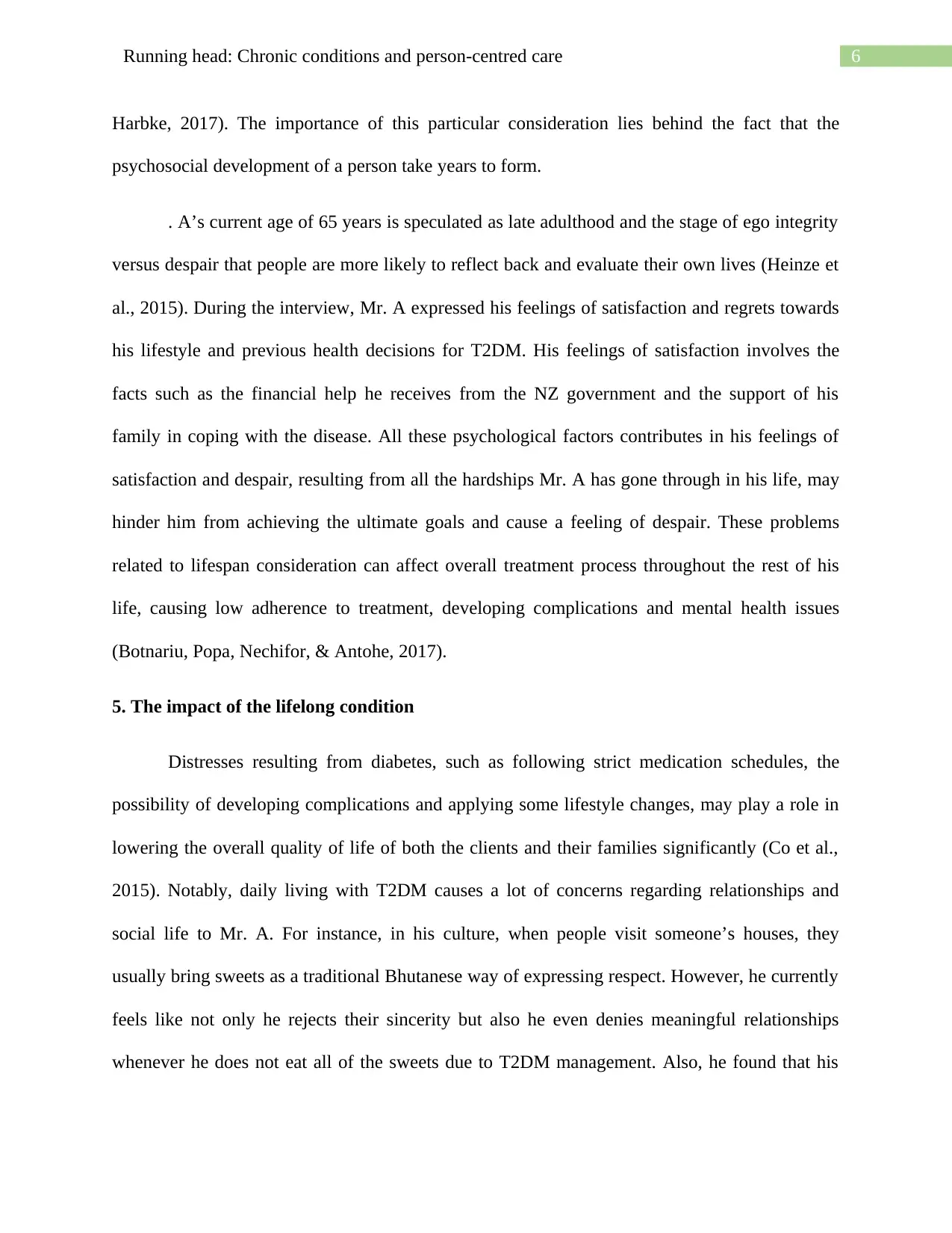
6Running head: Chronic conditions and person-centred care
Harbke, 2017). The importance of this particular consideration lies behind the fact that the
psychosocial development of a person take years to form.
. A’s current age of 65 years is speculated as late adulthood and the stage of ego integrity
versus despair that people are more likely to reflect back and evaluate their own lives (Heinze et
al., 2015). During the interview, Mr. A expressed his feelings of satisfaction and regrets towards
his lifestyle and previous health decisions for T2DM. His feelings of satisfaction involves the
facts such as the financial help he receives from the NZ government and the support of his
family in coping with the disease. All these psychological factors contributes in his feelings of
satisfaction and despair, resulting from all the hardships Mr. A has gone through in his life, may
hinder him from achieving the ultimate goals and cause a feeling of despair. These problems
related to lifespan consideration can affect overall treatment process throughout the rest of his
life, causing low adherence to treatment, developing complications and mental health issues
(Botnariu, Popa, Nechifor, & Antohe, 2017).
5. The impact of the lifelong condition
Distresses resulting from diabetes, such as following strict medication schedules, the
possibility of developing complications and applying some lifestyle changes, may play a role in
lowering the overall quality of life of both the clients and their families significantly (Co et al.,
2015). Notably, daily living with T2DM causes a lot of concerns regarding relationships and
social life to Mr. A. For instance, in his culture, when people visit someone’s houses, they
usually bring sweets as a traditional Bhutanese way of expressing respect. However, he currently
feels like not only he rejects their sincerity but also he even denies meaningful relationships
whenever he does not eat all of the sweets due to T2DM management. Also, he found that his
Harbke, 2017). The importance of this particular consideration lies behind the fact that the
psychosocial development of a person take years to form.
. A’s current age of 65 years is speculated as late adulthood and the stage of ego integrity
versus despair that people are more likely to reflect back and evaluate their own lives (Heinze et
al., 2015). During the interview, Mr. A expressed his feelings of satisfaction and regrets towards
his lifestyle and previous health decisions for T2DM. His feelings of satisfaction involves the
facts such as the financial help he receives from the NZ government and the support of his
family in coping with the disease. All these psychological factors contributes in his feelings of
satisfaction and despair, resulting from all the hardships Mr. A has gone through in his life, may
hinder him from achieving the ultimate goals and cause a feeling of despair. These problems
related to lifespan consideration can affect overall treatment process throughout the rest of his
life, causing low adherence to treatment, developing complications and mental health issues
(Botnariu, Popa, Nechifor, & Antohe, 2017).
5. The impact of the lifelong condition
Distresses resulting from diabetes, such as following strict medication schedules, the
possibility of developing complications and applying some lifestyle changes, may play a role in
lowering the overall quality of life of both the clients and their families significantly (Co et al.,
2015). Notably, daily living with T2DM causes a lot of concerns regarding relationships and
social life to Mr. A. For instance, in his culture, when people visit someone’s houses, they
usually bring sweets as a traditional Bhutanese way of expressing respect. However, he currently
feels like not only he rejects their sincerity but also he even denies meaningful relationships
whenever he does not eat all of the sweets due to T2DM management. Also, he found that his
Paraphrase This Document
Need a fresh take? Get an instant paraphrase of this document with our AI Paraphraser
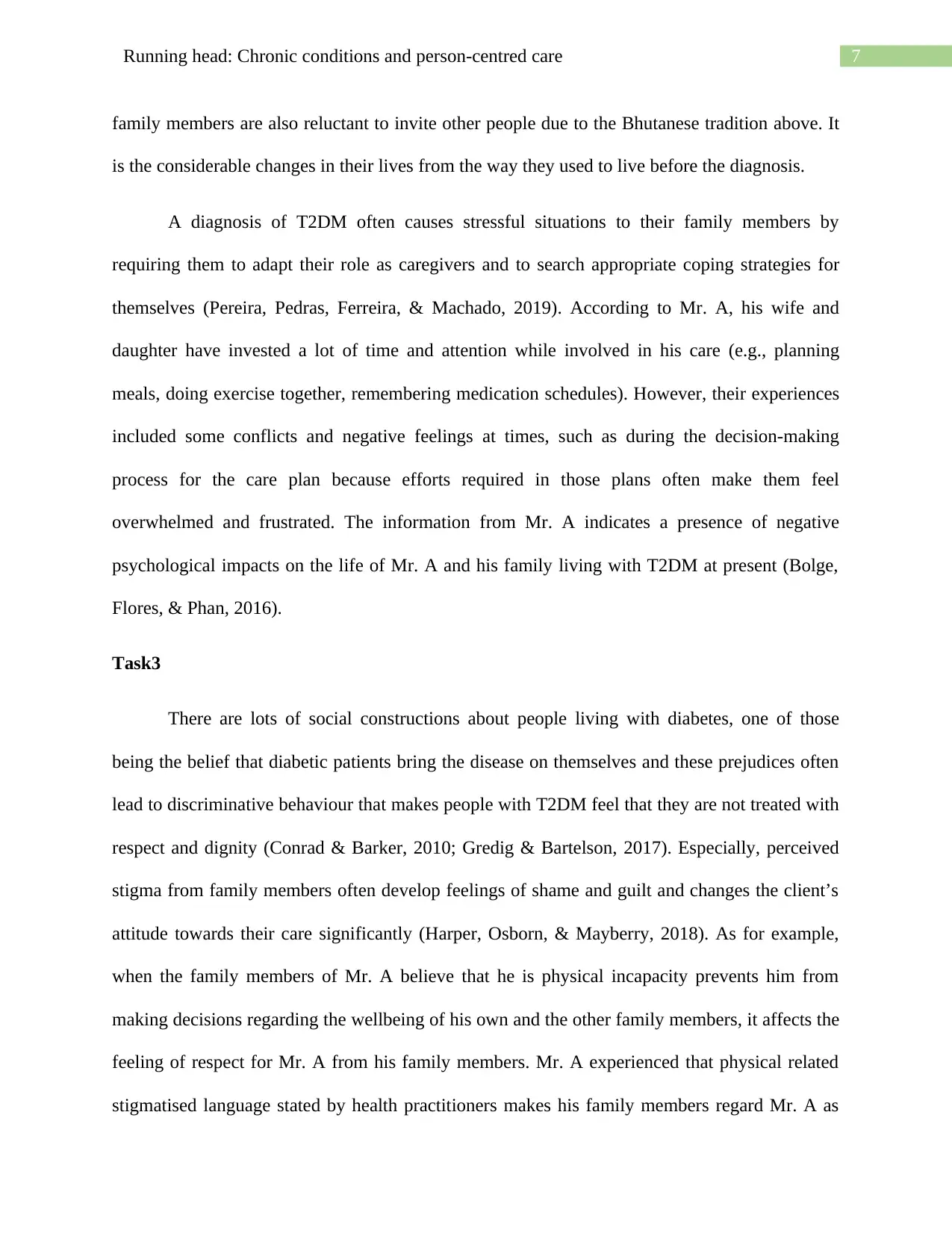
7Running head: Chronic conditions and person-centred care
family members are also reluctant to invite other people due to the Bhutanese tradition above. It
is the considerable changes in their lives from the way they used to live before the diagnosis.
A diagnosis of T2DM often causes stressful situations to their family members by
requiring them to adapt their role as caregivers and to search appropriate coping strategies for
themselves (Pereira, Pedras, Ferreira, & Machado, 2019). According to Mr. A, his wife and
daughter have invested a lot of time and attention while involved in his care (e.g., planning
meals, doing exercise together, remembering medication schedules). However, their experiences
included some conflicts and negative feelings at times, such as during the decision-making
process for the care plan because efforts required in those plans often make them feel
overwhelmed and frustrated. The information from Mr. A indicates a presence of negative
psychological impacts on the life of Mr. A and his family living with T2DM at present (Bolge,
Flores, & Phan, 2016).
Task3
There are lots of social constructions about people living with diabetes, one of those
being the belief that diabetic patients bring the disease on themselves and these prejudices often
lead to discriminative behaviour that makes people with T2DM feel that they are not treated with
respect and dignity (Conrad & Barker, 2010; Gredig & Bartelson, 2017). Especially, perceived
stigma from family members often develop feelings of shame and guilt and changes the client’s
attitude towards their care significantly (Harper, Osborn, & Mayberry, 2018). As for example,
when the family members of Mr. A believe that he is physical incapacity prevents him from
making decisions regarding the wellbeing of his own and the other family members, it affects the
feeling of respect for Mr. A from his family members. Mr. A experienced that physical related
stigmatised language stated by health practitioners makes his family members regard Mr. A as
family members are also reluctant to invite other people due to the Bhutanese tradition above. It
is the considerable changes in their lives from the way they used to live before the diagnosis.
A diagnosis of T2DM often causes stressful situations to their family members by
requiring them to adapt their role as caregivers and to search appropriate coping strategies for
themselves (Pereira, Pedras, Ferreira, & Machado, 2019). According to Mr. A, his wife and
daughter have invested a lot of time and attention while involved in his care (e.g., planning
meals, doing exercise together, remembering medication schedules). However, their experiences
included some conflicts and negative feelings at times, such as during the decision-making
process for the care plan because efforts required in those plans often make them feel
overwhelmed and frustrated. The information from Mr. A indicates a presence of negative
psychological impacts on the life of Mr. A and his family living with T2DM at present (Bolge,
Flores, & Phan, 2016).
Task3
There are lots of social constructions about people living with diabetes, one of those
being the belief that diabetic patients bring the disease on themselves and these prejudices often
lead to discriminative behaviour that makes people with T2DM feel that they are not treated with
respect and dignity (Conrad & Barker, 2010; Gredig & Bartelson, 2017). Especially, perceived
stigma from family members often develop feelings of shame and guilt and changes the client’s
attitude towards their care significantly (Harper, Osborn, & Mayberry, 2018). As for example,
when the family members of Mr. A believe that he is physical incapacity prevents him from
making decisions regarding the wellbeing of his own and the other family members, it affects the
feeling of respect for Mr. A from his family members. Mr. A experienced that physical related
stigmatised language stated by health practitioners makes his family members regard Mr. A as

8Running head: Chronic conditions and person-centred care
the one to be protected rather than the head of the family, who is supposed to protect and make
the decisions for the well-being of the whole family. Also, Mr. A found that his family members
assume that Mr. A could have a shorter life expectancy because they constantly talk about the
possibility of the death of Mr. A during a discussion for his treatment, regardless of current good
health status of Mr. A. The family support is considered one of the most important positive
contributor in the diabetic treatment. Although the unpleasant experiences caused by the
stigmatised attitude of the family members of Mr. A, may result in an unintended harmful effects
to the life of Mr. A with diabetes. The situations involve concealing one’s condition or stopping
efforts for self-care (Wietjens & Cairns, 2012; Harper, Osborn, & Mayberry, 2018).
According to a study, in New Zealand, a considerable number of healthy people tend to
associate the onset of diabetes with individuals’ poor health habits and they also consider the
individuals with T2DM as normal people who do have difficulties in carrying on normal life
(Andelson-Lister & Treharne, 2014). There are some instances as per the experiences of Mr. A,
where people blame him as a contributor to T2DM. For example, one of his best friends has the
habit to criticize the life style led by Mr. A and to advise that Mr. A should have done more
exercise or eaten healthier food before he had been diagnosed in the first place. There are many
prejudices that Mr. A had to endure from the society. Some of those include that Mr. A could
lose his consciousness all of a sudden, or that he cannot complete a specific task successfully,
and also that his daughter might have the same health problems like him. On the other hand, the
positive effects of the diabetes-related stigma involves developing risk perception, which enables
Mr. A to engage in his treatment actively (Shreck, Gonzalez, Cohen, & Walker, 2014). However,
it also expected that Mr. A might internalise such negative stereotypes and self-blame much
more than before and this can make him keep his condition private and being reluctant to access
the one to be protected rather than the head of the family, who is supposed to protect and make
the decisions for the well-being of the whole family. Also, Mr. A found that his family members
assume that Mr. A could have a shorter life expectancy because they constantly talk about the
possibility of the death of Mr. A during a discussion for his treatment, regardless of current good
health status of Mr. A. The family support is considered one of the most important positive
contributor in the diabetic treatment. Although the unpleasant experiences caused by the
stigmatised attitude of the family members of Mr. A, may result in an unintended harmful effects
to the life of Mr. A with diabetes. The situations involve concealing one’s condition or stopping
efforts for self-care (Wietjens & Cairns, 2012; Harper, Osborn, & Mayberry, 2018).
According to a study, in New Zealand, a considerable number of healthy people tend to
associate the onset of diabetes with individuals’ poor health habits and they also consider the
individuals with T2DM as normal people who do have difficulties in carrying on normal life
(Andelson-Lister & Treharne, 2014). There are some instances as per the experiences of Mr. A,
where people blame him as a contributor to T2DM. For example, one of his best friends has the
habit to criticize the life style led by Mr. A and to advise that Mr. A should have done more
exercise or eaten healthier food before he had been diagnosed in the first place. There are many
prejudices that Mr. A had to endure from the society. Some of those include that Mr. A could
lose his consciousness all of a sudden, or that he cannot complete a specific task successfully,
and also that his daughter might have the same health problems like him. On the other hand, the
positive effects of the diabetes-related stigma involves developing risk perception, which enables
Mr. A to engage in his treatment actively (Shreck, Gonzalez, Cohen, & Walker, 2014). However,
it also expected that Mr. A might internalise such negative stereotypes and self-blame much
more than before and this can make him keep his condition private and being reluctant to access
⊘ This is a preview!⊘
Do you want full access?
Subscribe today to unlock all pages.

Trusted by 1+ million students worldwide

9Running head: Chronic conditions and person-centred care
health care services over time (Crowe et al., 2017). The diabetes related stigma may affect the
life of a diabetic patient in both positive and negative way and it depends upon the patient and
the society surrounding him or her, how it affects the life of an individual.
Task4
From the information provided Mr. A, the adequate nursing care plans to address his
needs for T2DM management can be established for better health outcomes. Firstly, the
improvement of the self-management skills of Mr. A and his family is urgent because Mr. A only
checks the blood glucose level and omits medications frequently. Mr. A stated that he has had
difficulties in T2DM management and did not understand why it is required exactly as
communications with GP as only receiving health information for his T2DM management
(Crowe et al., 2017). Thus, educational interventions, such as providing opportunities for
education programmes, can bring positive outcomes for self-management skill of Mr. A and his
family, contributing to the establishment of basic knowledge of T2DM, ideal goal and specific
action plans (Higgs, Skinner, & Hale, 2016). Although Mr. A and his family members have some
communication problems as English is their second language, personalised educational
opportunities can improve the daily management of T2DM and thus minimise physical
complications (Ministry of Health, 2015; Gamble et al., 2017). Secondly, lifestyle interventions
can be beneficial for Mr. A concerning a current lack of exercise and an unbalanced diet. Even
though he received some general information regarding exercise and diet options, he does not
know which food he has to eat or how much time he has to do exercise. Implementation of Green
Prescription can be good care option for Mr. A for contributing to developing a healthy lifestyle
and alleviating diabetic symptoms in a timely and appropriate manner. Nurses also can monitor
Mr. A’s progress as frequently as possible and encourage his engagement in lifestyle
health care services over time (Crowe et al., 2017). The diabetes related stigma may affect the
life of a diabetic patient in both positive and negative way and it depends upon the patient and
the society surrounding him or her, how it affects the life of an individual.
Task4
From the information provided Mr. A, the adequate nursing care plans to address his
needs for T2DM management can be established for better health outcomes. Firstly, the
improvement of the self-management skills of Mr. A and his family is urgent because Mr. A only
checks the blood glucose level and omits medications frequently. Mr. A stated that he has had
difficulties in T2DM management and did not understand why it is required exactly as
communications with GP as only receiving health information for his T2DM management
(Crowe et al., 2017). Thus, educational interventions, such as providing opportunities for
education programmes, can bring positive outcomes for self-management skill of Mr. A and his
family, contributing to the establishment of basic knowledge of T2DM, ideal goal and specific
action plans (Higgs, Skinner, & Hale, 2016). Although Mr. A and his family members have some
communication problems as English is their second language, personalised educational
opportunities can improve the daily management of T2DM and thus minimise physical
complications (Ministry of Health, 2015; Gamble et al., 2017). Secondly, lifestyle interventions
can be beneficial for Mr. A concerning a current lack of exercise and an unbalanced diet. Even
though he received some general information regarding exercise and diet options, he does not
know which food he has to eat or how much time he has to do exercise. Implementation of Green
Prescription can be good care option for Mr. A for contributing to developing a healthy lifestyle
and alleviating diabetic symptoms in a timely and appropriate manner. Nurses also can monitor
Mr. A’s progress as frequently as possible and encourage his engagement in lifestyle
Paraphrase This Document
Need a fresh take? Get an instant paraphrase of this document with our AI Paraphraser

10Running head: Chronic conditions and person-centred care
interventions through such nursing care (Daly, Arroll, Kenealy, Sheridan, & Scragg, 2015).
However, such lifestyle interventions would not be suitable for Mr. A considering his physical
age, which may prevent him from exercising or specific cultural beliefs reflected on food, such
as accepting sweets is a necessity to express the gratitude while interacting socially. Thus, these
limitations also should be carefully considered for the long-term effectiveness of this plan
(Hamlin, Yule, Elliot, Stoner, & Kathiravel, 2016). Lastly, the psychological status of Mr. A
should be assessed and addressed adequately. Although Mr. A has been experiencing lots of
stressful situations regarding migration to NZ and his health conditions, as discussed in brief in
the previous sections, his psychological state have never been addressed since his diagnosis of
T2DM, which have left his mental health vulnerable. Also, he reported that he recently suffers
from fitful night sleep. Thus, some necessary psychological interventions must be made
addressing this issue. Those interventions include assessing diabetes distress and developing
appropriate treatment and follow-up plans for Mr. A to enable the nurses to minimise the risk of
developing mental health issues. However, the success of this interventional approach depends
on the fact of the availability of an integrated treatment, in which various kinds of health
practitioners, like general practitioners and psychiatrists, are closely collaborated as a team
(Snoek, Bremmer, & Hermanns, 2015).
Conclusion
The comprehensive examination of people with lifelong conditions can be beneficial
because such chronic illnesses require inclusive everyday management. This essay has explained
the features of T2DM in various perspectives through the information provided Mr. A. Also, it
has evaluated the impact of T2DM on the life of Mr. A and his family. Furthermore, the social
construction of T2DM has been discussed as a contributor affecting the quality of life of people
interventions through such nursing care (Daly, Arroll, Kenealy, Sheridan, & Scragg, 2015).
However, such lifestyle interventions would not be suitable for Mr. A considering his physical
age, which may prevent him from exercising or specific cultural beliefs reflected on food, such
as accepting sweets is a necessity to express the gratitude while interacting socially. Thus, these
limitations also should be carefully considered for the long-term effectiveness of this plan
(Hamlin, Yule, Elliot, Stoner, & Kathiravel, 2016). Lastly, the psychological status of Mr. A
should be assessed and addressed adequately. Although Mr. A has been experiencing lots of
stressful situations regarding migration to NZ and his health conditions, as discussed in brief in
the previous sections, his psychological state have never been addressed since his diagnosis of
T2DM, which have left his mental health vulnerable. Also, he reported that he recently suffers
from fitful night sleep. Thus, some necessary psychological interventions must be made
addressing this issue. Those interventions include assessing diabetes distress and developing
appropriate treatment and follow-up plans for Mr. A to enable the nurses to minimise the risk of
developing mental health issues. However, the success of this interventional approach depends
on the fact of the availability of an integrated treatment, in which various kinds of health
practitioners, like general practitioners and psychiatrists, are closely collaborated as a team
(Snoek, Bremmer, & Hermanns, 2015).
Conclusion
The comprehensive examination of people with lifelong conditions can be beneficial
because such chronic illnesses require inclusive everyday management. This essay has explained
the features of T2DM in various perspectives through the information provided Mr. A. Also, it
has evaluated the impact of T2DM on the life of Mr. A and his family. Furthermore, the social
construction of T2DM has been discussed as a contributor affecting the quality of life of people

11Running head: Chronic conditions and person-centred care
living with the lifelong condition. In addition, appropriate nursing care needs for Mr. A at his
present health stage have been discussed for improving the overall well-being of Mr. A.
Ultimately, such comprehensive approaches for dealing with problems, which people with the
lifelong conditions may face during their treatment, will contribute to the improvement of quality
of life and better health outcomes.
living with the lifelong condition. In addition, appropriate nursing care needs for Mr. A at his
present health stage have been discussed for improving the overall well-being of Mr. A.
Ultimately, such comprehensive approaches for dealing with problems, which people with the
lifelong conditions may face during their treatment, will contribute to the improvement of quality
of life and better health outcomes.
⊘ This is a preview!⊘
Do you want full access?
Subscribe today to unlock all pages.

Trusted by 1+ million students worldwide
1 out of 17
Related Documents
Your All-in-One AI-Powered Toolkit for Academic Success.
+13062052269
info@desklib.com
Available 24*7 on WhatsApp / Email
![[object Object]](/_next/static/media/star-bottom.7253800d.svg)
Unlock your academic potential
Copyright © 2020–2025 A2Z Services. All Rights Reserved. Developed and managed by ZUCOL.




